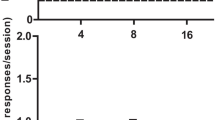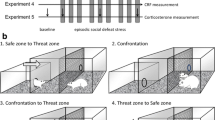Abstract
Defeat and the threat of defeat by an aggressive conspecific is stressful and may engender an anxiety-or fear-like state in animals; the present experiment investigated whether defeat generalized to the discriminative stimulus properties of PTZ and how benzodiazepine receptors were involved in this generalization. Separate groups of male Long-Evans rats (Rattus norvegicus) were trained to discriminate 20 mg/kg pentylenetetrazole (PTZ) or 0.4 mg/kg midazolam (MDZ) from saline in a two-choice drug-discrimination task. After establishing stimulus control, PTZ- and MDZ-trained rats were exposed to an aggressive conspecific which resulted in defeat, as defined by the display of defensive and submissive postures as well as audible and ultrasonic vocalizations. Administration of saline after defeat resulted in greater than 80% PTZ lever selection in 15 out of 25 PTZ-trained rats; this effect was attenuated through pretreatment with MDZ (1 mg/kg). Furthermore, short-term defeat substitution for the PTZ discriminative stimulus was not accompanied by long-term changes in the post-defeat generalization curves for PTZ and MDZ when compared to pre-defeat generalization curves. Nor did defeat alter the antagonism of PTZ by diazepam (2.5 mg/kg) or MDZ by flumazenil (10 mg/kg). In order further to characterize the necessary features for defeat substitution for the PTZ discriminative stimulus, exposure to a threatening conspecific was also attempted by PTZ-trained rats protected from physical contact with a wire mesh cage. In these tests, saline continued to engender greater than 50% PTZ lever responding in 15 of 25 rats. These results suggest that an anxiety-like state is induced during defeat and exposure to a threatening conspecific in most rats; this state, as well as the PTZ discriminative stimulus, can be reversed by benzodiazepine receptor agonists. In contrast, short-term defeat substitution for the PTZ discriminative stimulus does not appear to be related to long-term alterations in the benzodiazepine receptor.
Similar content being viewed by others
References
Alho H, Costa E, Ferrero P, Fujimoto M, Cosenza-Murphy D, Guidotti A (1985) Diazepam-binding inhibitor: a neuropeptide located in selected neuronal populations of rat brain. Science 229:179–182
Andrews JS, Stephens DN (1990) Drug discrimination models in anxiety and depression. Pharmacol Ther 47:267–280
Ator NA, Griffiths RR (1989) Differential generalization to pentobarbital in rats trained to discriminate lorazepam, chlordiazepoxide, diazepam, or triazolam. Psychopharmacology 98:20–30
Ator NA, Cook JM, Griffiths RR (1989) Drug discrimination in pentylenetetrazol-trained baboons: generalization to buspirone and b-carboline-3-carboxylic acid ethyl ester but not lorazepam or pentobarbital. Drug Dev Res 16:257–267
Costa E, Rodbard D, Pert CB (1979) Is the benzodiazepine receptor coupled to a chloride ion channel? Nature 277:315–317
DeVry J, Slangen JL (1986) Effects of training dose on discrimination and cross-generalization of chlordiazepoxide, pentobarbital and ethanol in the rat. Psychopharmacology 88:341–345
Emmett-Oglesby MW, Spencer D, Lewis M, Elmesallamy F, Lal H (1983) Anxiogenic aspects of diazepam withdrawal can be detected in animals. Eur J Pharmacol 92:127–130
Emmett-Oglesby MW, Harris CM, Lane JD, Lal H (1984) Withdrawal from morphine generalizes to a pentylenetetrazol stimulus. Neuropeptides 5:37–40
Evans SM, Johanson CE (1989) Discriminative stimulus properties of midazolam in the pigeon. J Pharmacol Exp Ther 248:29–38
Fokkema DS, Smit K, van der Gugten J, Koolhaas JM (1988) A coherent pattern among social behavior, blood pressure, corticosterone and catecholamine measures in individual male rats. Physiol Behav 42:485–489
Garcha HS, Rose IC, Stolerman IP (1985) Midazolam cue in rats: generalization tests with anxiolytic and other drugs. Psychopharmacology 87:233–237
Gauvin DV, Holloway FA (1991) Cross-generalization between an ecologically relevant stimulus and a pentylenetetrazol-discriminative cue. Pharmacol Biochem Behav 39:521–523
Glowa JR, Barrett JE (1983) Drug history modifies the behavioral effects of pentobarbital. Science 220:333–335
Greenblatt DJ, Shader RI, Divoli M, Harmatz JS (1981) Benzodiazepines: a summary of pharmacokinetic properties. Br J Clin Pharmacol 11:11s-16s
Haefely W (1985) Pharmacology of benzodiazepine antagonists. Pharmacopsychiatry 18:163–166
Haefely W (1988) Benzodiazepines. Int Anesthesiol Clin 26:262–272
Haefely W (1990) The GABAA-benzodiazepine receptor: biology and pharmacology. In: Burrows GD, Roth M, Noyes R (eds) Handbook of anxiety, Vol. 3: The neurobiology of anxiety. Elsevier, Amsterdam, pp 165–188
Harris CM, Emmett-Oglesby MW, Robinson NG, Lal H (1986) Withdrawal from chronic nicotine substitutes partially for the interoceptive stimulus produced by pentylenetetrazole (PTZ). Psychopharmacology 90:85–89
Harris CM, Benjamin D, Lal H (1987) Anxiety-like subjective effects of ethanol antagonist Ro15-4513 demonstrated in pentylenetetrazole discrimination. Neuropharmacology 26:1545–1547
Heinrichs SC, Merlo Pich E, Miczek KA, Britton KT, Koob GF (1992) Corticotropin-releasing factor antagonist reduces emotionality in socially defeated rats via direct neurotropic action. Brain Res 581:190–197
Kang I, Thompson ML, Heller J, Miller LG (1991) Persistent elevation in GABAA receptor subunit mRNAs following social stress. Brain Res Bull 26:809–812
Lal H, Emmett-Oglesby MW (1983) Behavioral analogues of anxiety-Animal models. Neuropharmacol 22:1423–1441
Lal H, Shearman GT (1982) Attenuation of chemically induced anxiogenic stimuli as a novel method for evaluating anxiolytic drugs: a comparison of clobazam with other benzodiazepines. Drug Dev Res 1:127–134
Lal H, Harris CM, Benjamin D, Springfield AC, Bhadra S, Emmett-Oglesby MW (1988) Characterization of pentylenetetrazol-like interoceptive stimulus produced by ethanol withdrawal. J Pharmacol Exp Ther 24:508–518
Meehan WP, Tornatzky W, Miczek KA (1994) Blood pressure via telemetry during social confrontations in rats: effects of clonidine. Physiol Behav (submitted)
Miczek KA (1979) A new test for aggression in rats without aversive stimulation: differential effects ofd-amphetamine and cocaine. Psychopharmacology 60:253–259
Miczek KA (1991) Tolerance to the analgesic, but not discriminative stimulus effects of morphine after brief social defeat in rats. Psychopharmacology 104:181–186
Miczek KA, Thompson ML, Tornatzky W (1991) Subordinate animals: behavioral and physiological adaptations and opioid tolerance. In: Brown M, Koob G, Rivier C (eds) Neurobiology of stress. Marcel Dekker, New York, pp 323–357
Miller LG, Thompson ML, Greenblatt DJ, Deutsch SI, Shader RI (1987) Rapid increase in brain benzodiazepine receptor binding following defeat stress in mice. Brain Res 414:395–400
Rodin EA, Calhoun HD (1970) Metrazol in a “normal” volunteer population. J Nerv Ment, Dis 150:438–450
Tornatzky W, Miczek KA (1993) Long-term impairment of autonomic circadian rhythms after brief intermittent social stress. Physiol Behav 53:983–993
Tornatzky W, Miczek KA (1994) Behavioral and autonomic responses to intermittent social stress: differential protection by clonidine and metroprolol. Psychopharmacology (in press)
Vellucci SV, Martin PJ, Everitt BJ (1988) The discriminative stimulus produced by pentylenetetrazol: effects of systemic anxiolytics and anxiogenics, aggressive defeat and midazolam or muscimol infused into the amygdala. J Psychopharmacol 2:80–93
Vivian JA, Miczek KA (1991) Ultrasounds during morphine withdrawal in rats. Psychopharmacology 104:187–193
Vivian JA, Miczek KA (1993a) Diazepam and gepirone selectively attenuate either 20–32 kHz or 32–64 kHz ultrasonic vocalizations during aggressive encounters. Psychopharmacology 112:66–73
Vivian JA, Miczek KA (1993b) Morphine attenuates ultrasonic vocalization during agonistic encounters in adult male rats. Psychopharmacology 111:367–375
Wenger GR (1980) Cumulative dose-response curves in behavioral pharmacology. Pharmacol Biochem Behav 13:647–651
Wood DM, Laraby PR, Lal H (1989) A pentylenetetrazol-like stimulus during cocaine withdrawal: blockade by diazepam and not haloperidol. Drug Dev Res 16:269–276
Author information
Authors and Affiliations
Additional information
Present address: Division of Behavioral Biology, Johns Hopkins University School of Medicine, Hopkins Bayview Research Campus, Baltimore, MD 21224, USA
Rights and permissions
About this article
Cite this article
Vivian, J.A., Weerts, E.M. & Miczek, K.A. Defeat engenders pentylenetetrazole-appropriate responding in rats: antagonism by midazolam. Psychopharmacology 116, 491–498 (1994). https://doi.org/10.1007/BF02247483
Received:
Revised:
Issue Date:
DOI: https://doi.org/10.1007/BF02247483




